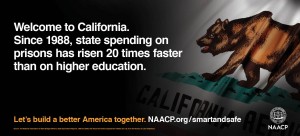Along with failing to keep society safer overall, Alleyne said mass incarceration also tends to result in more dangerous prisons. Many non-violent offenders tend to leave prison more violent than when they entered, she said. “One of the consequences of overspending on prisons is overcrowding which often leads to rape,” she said. “It is estimated that 216,000 adults and juveniles are forcibly raped in American prisons and jails every year. That comes out to about 600 adults and juveniles getting raped in prisons and jails every day.” 
Juvenile justice system reform is also a major part of the growing discussion on the issue, as it costs more to incarcerate children than adults.
“The national average is $88,000 per youth offender,” Rooks said, referring to the costs for providing housing, medical treatment, education and security for child offenders. “We aren’t suggesting that less money be spent per child, the broader issue is looking at how we are currently spending that $88,000 on a child with a wide range of issues.”
Rooks cited Harrisburg, Pa., as a worse case scenario. “This year $1.5 billion was diverted from education funding there while two new prisons are being built,” he said. Rooks said the juvenile justice system has steadily grown harsher.
“Over the past 20 to 30 years we have seen increased criminalization of our youth,” he said. “We live in a society that criminalizes its people more and more. Children are getting arrested and being brought to court for the same offenses that used to land you in the principal’s office when I was a kid.”
Georgia has joined in the prison reform debate. Gov. Nathan Deal announced earlier this year his plans to assemble a new bi-partisan council to study criminal justice reforms and make recommendations to a joint legislative committee by next January. Georgia has the fourth highest incarceration rate of adults in the nation, costing taxpayers more than $1 billion a year.
Among some the NAACP report’s key findings are:

An NAACP billboard in California.
• In most major cities, a significant portion of the prison population hails from a small number of low-income communities.“Millions of dollars are being spent every year to incarcerate a high number of people from just a few neighborhoods,” Rooks said.
• The majority of people incarcerated – in some communities as much as 60 percent – are abuse victims or are suffering from mental health conditions. “Prisons have become a place for warehousing people who have been physically and sexually abused or those with substance abuse problems or mental health issues,” Rooks said.
• More than half of the women in state prisons had been physically or sexually abused prior to their incarceration. “What we’re saying is that there is another way we can address these issues other than mass incarceration,” said Rooks.
• Most incarcerated people are behind bars for non-violent offenses. “We’re doing this to non-violent offenders and putting them in the position where they’ve got to defend themselves [from violent offenders in prison],” Rooks said. “Our over investment into prisons as a nation has created a political incentive for politicians to feel the need to show they are being ‘tough on crime’ by instituting get-tough policies that ultimately don’t make us any safer.”
Both Rooks and Alleyne agreed that there is room for everyone on all sides of the political spectrum to get behind the prison reform issue. “This is not about party lines; this is something that we all can agree on,” Alleyne said. “We all can agree that we care about public safety and spending. This is an across the aisle issue.”
The report is part of NAACP’s “Smart and Safe Campaign,” a nationwide effort to influence state budgets and a push to shift prison spending to education. The NAACP is also launching a multi-city billboard campaign that will feature criminal justice statistics, such as the fact that the U.S. accounts for five percent of the world’s population but 25 percent of its prisoners.

The words of the 13th Amendment equate private slavery with the state slavery of modern incarceration. Involuntary servitude after being duly convicted of crime is allowed; and legally the state owns 100% of the labor of prisoners. Every warden would like to keep his or her prisoners busy with work, but the federal & state governments quash prison industries with restrictive legislation. We need to put most of our 2.3 million prisoners to work in secure private businesses, manufacturing goods now made exclusively overseas, and without wage & hour laws keeping wages too high. Governments have a double monopoly over prison industries & labor — this needs to end for the benefit of prisoners, victims, families, the state and the entire American economy. We cannot afford this many prisoners!
Read “Prison & Slavery – A Surprising Comparison” for answers!
Thank you for the recommendation. After working 27 years in the Federal Bureau of Prisons I find no comparison between current imprisonment and slavery. Slavery was a despicable institution that took innocent people from their homeland for the selfish benefit of a few white landowners. Our modern correctional system is filled with people who have harmed others in some form and been tried and sentenced.
In today’s prisons, especially federal, a person can enter as a functional illiterate and be released with a college degree. They can participate in drug treatment, counseling, and vocational training. This is of course if they choose to do so. They can also choose to warehouse themselves throughout their incarceration. These are the people who come out, commit another crime, then after re-arrest proclaim, “They didn’t rehabilitate me”. One of my many jobs within the system was in community corrections. We transitioned (I prefer that term to reentry) virtually all inmates through community treatment centers where they could gain employment and prepare for life as free citizens.
The system MUST change. But not by focusing on prison reform. We’ve had prison reform for hundreds of years. The American penitentiary was itself a reformation of the old system of incarceration. The system needs to be TRANSFORMED. The problem with reform efforts is that we keep jumping to the answers without asking the right questions. I’m limited by space in listing those questions but I hope we can some day make this transformation.
The proposition of improving our criminal justice system primarily through prison reform is wrong for a number of reasons. Most important of these is the fact that the premise for reform is faulty. Our criminal justice system DOES NOT rely too much on incarceration.
According to the Bureau of Justice Statistics (BJS) at the end of 2009 our country had 7,225,800 individuals under correctional supervision. Of this number 2,284,913 were in prison or jail while 5,023,275 were on community supervision (also called community corrections). This means that about 70% of our correctional population is on some type of “alternative” sentence rather that in prison or jail. Probation alone with 4,203,967 individuals under supervision makes up the major portion of the community corrections population. One could say that in this country incarceration IS an alternative sentence. If the goal of Right on Crime and other likeminded organizations is to shift the number of people in prison into alternative community supervision programs; Mission accomplished! Fixing our criminal justice system will require more than merely reshuffling bodies or altering sentencing. We don’t need to reform the system. We must TRANSFORM it.
Thanks so much for your comments! We look forward to your feedback on other stories in the future.
JJIE